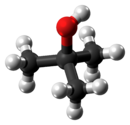tert-Butyl alcohol
| |||

| |||
| Names | |||
|---|---|---|---|
| Preferred IUPAC name
2-Methylpropan-2-ol | |||
Other names
| |||
| Identifiers | |||
3D model (
JSmol ) |
|||
| 906698 | |||
| ChEBI | |||
| ChEMBL | |||
| ChemSpider | |||
| DrugBank | |||
ECHA InfoCard
|
100.000.809 | ||
| EC Number |
| ||
| 1833 | |||
| MeSH | tert-Butyl+Alcohol | ||
PubChem CID
|
|||
RTECS number
|
| ||
| UNII | |||
| UN number | 1120 | ||
CompTox Dashboard (EPA)
|
|||
| |||
| |||
| Properties | |||
| C4H10O | |||
| Molar mass | 74.123 g·mol−1 | ||
| Appearance | Colorless solid | ||
| Odor | Camphorous | ||
| Density | 0.775 g/mL | ||
| Melting point | 25 to 26 °C; 77 to 79 °F; 298 to 299 K | ||
| Boiling point | 82 to 83 °C; 179 to 181 °F; 355 to 356 K | ||
| miscible[2] | |||
| log P | 0.584 | ||
| Vapor pressure | 4.1 kPa (at 20 °C) | ||
| Acidity (pKa) | 16.54 [3] | ||
| 5.742×10−5 cm3/mol | |||
Refractive index (nD)
|
1.387 | ||
| 1.31 D | |||
| Thermochemistry | |||
Heat capacity (C)
|
215.37 J K−1 mol−1 | ||
Std molar
entropy (S⦵298) |
189.5 J K−1 mol−1 | ||
Std enthalpy of (ΔfH⦵298)formation |
−360.04 to −358.36 kJ mol−1 | ||
Std enthalpy of (ΔcH⦵298)combustion |
−2.64479 to −2.64321 MJ mol−1 | ||
| Hazards | |||
| GHS labelling: | |||
 
| |||
| Danger | |||
| H225, H319, H332, H335 | |||
| P210, P261, P305+P351+P338 | |||
| NFPA 704 (fire diamond) | |||
| Flash point | 11 °C (52 °F; 284 K) | ||
| 480 °C (896 °F; 753 K) | |||
Explosive limits
|
2.4–8.0% | ||
| Lethal dose or concentration (LD, LC): | |||
LD50 (median dose)
|
3559 mg/kg (rabbit, oral) 3500 mg/kg (rat, oral)[4] | ||
| NIOSH (US health exposure limits): | |||
PEL (Permissible)
|
TWA 100 ppm (300 mg/m3)[1] | ||
REL (Recommended)
|
TWA 100 ppm (300 mg/m3) ST 150 ppm (450 mg/m3)[1] | ||
IDLH (Immediate danger) |
1600 ppm[1] | ||
| Safety data sheet (SDS) | inchem.org | ||
| Related compounds | |||
Related butanols
|
2-Butanol n-Butanol Isobutanol | ||
Related compounds
|
2-Methyl-2-butanol Trimethylsilanol | ||
Except where otherwise noted, data are given for materials in their standard state (at 25 °C [77 °F], 100 kPa).
| |||
tert-Butyl alcohol is the simplest
Natural occurrence
tert-Butyl alcohol has been identified in beer and chickpeas.[5] It is also found in cassava,[6] which is used as a fermentation ingredient in certain alcoholic beverages.
Preparation
tert-Butyl alcohol is derived commercially from isobutane as a coproduct of propylene oxide production. It can also be produced by the catalytic hydration of isobutylene, or by a Grignard reaction between acetone and methylmagnesium chloride.
Purification cannot be performed by simple distillation due to formation of an
Applications
tert-Butyl alcohol is used as a solvent, ethanol
Reactions
As a tertiary alcohol, tert-butyl alcohol is more resistant to oxidation than the other isomers of butanol.
tert-Butyl alcohol is deprotonated with a strong base to give the alkoxide. Particularly common is potassium tert-butoxide, which is prepared by treating tert-butanol with potassium metal.[8]
- K + t-BuOH → t-BuO−K+ + 1/2 H2
The tert-butoxide is a strong, non-
tert-Butyl alcohol reacts with hydrogen chloride to form tert-butyl chloride.
O-Chlorination of tert-butyl alcohol with hypochlorous acid to give
- (CH3)3COH + HOCl → (CH3)3COCl + H2O
Pharmacology and toxicology
There is limited data on the pharmacology and toxicology of tert-butanol in humans and other animals.[10] Human exposure may occur due to fuel oxygenate metabolism. Tert-butanol is poorly absorbed through skin but rapidly absorbed if inhaled or ingested. Tert-butanol is irritating to skin or eyes. Toxicity of single doses is usually low but high doses can produce a sedative or anesthetic effect.
References
- ^ a b c d NIOSH Pocket Guide to Chemical Hazards. "#0078". National Institute for Occupational Safety and Health (NIOSH).
- ^ "ICSC 0114 – tert-Butanol". Inchem.org. Retrieved 29 March 2018.
- doi:10.1139/v79-444.
- ^ "tert-Butyl alcohol". Immediately Dangerous to Life or Health Concentrations (IDLH). National Institute for Occupational Safety and Health (NIOSH).
- ^ "t-Butyl Alcohol". National Library of Medicine HSDB Database. National Institute for Health. Retrieved 29 March 2018.
- ^ "Archived copy" (PDF). Archived from the original (PDF) on 2016-03-04. Retrieved 2013-03-05.
{{cite web}}: CS1 maint: archived copy as title (link) - ISBN 9780080347141.
- .
- .
- S2CID 26041562.
External links
- International Chemical Safety Card 0114
- NIOSH Pocket Guide to Chemical Hazards. "#0078". National Institute for Occupational Safety and Health (NIOSH).
- Environmental Health Criteria 65: Butanols: four isomers
- IPCS Health and Safety Guide 7: tert-Butanol



